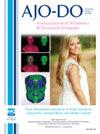美国牙科正畸委员会:正畸认证程序的简史和更新。
IF 2.7
2区 医学
Q1 DENTISTRY, ORAL SURGERY & MEDICINE
American Journal of Orthodontics and Dentofacial Orthopedics
Pub Date : 2024-10-01
DOI:10.1016/j.ajodo.2024.07.001
引用次数: 0
摘要
美国牙科正畸委员会(ABO)更新了其临床考试流程,以消除基于病例的考试的障碍,并将获得委员会认证的正畸医师与提供正畸护理的未经认证的牙科医生区分开来。2017 年,ABO 大胆地采用了新的临床考试形式(情景模拟考试),从而解决了以前基于病例的考试形式所固有的挑战。2019年冠状病毒疾病大流行迫使原定于2020年7月举行的情景模拟临床考试被迫取消。这促使 ABO 重新组合,将情景模拟临床考试调整为可在全球范围内的考试中心环境中进行的形式,从而无需前往密苏里州圣路易斯市。ABO 的书面考试则保持不变。自采用情景模拟考试形式以来,AAO 63% 的成员已获得了委员会认证,并且呈上升趋势。我们的使命是通过认证、教育和专业合作提高正畸质量,为了支持这一使命,ABO有责任以公平、可靠和有效的方式对正畸医师进行认证。这就需要对我们的认证程序进行持续的评估和审查,以确保我们的考试能够可靠地评估正畸医师提供最高水平患者护理的能力。本文章由计算机程序翻译,如有差异,请以英文原文为准。
The American Board of Orthodontics: A brief history and update of the orthodontic certification process
The American Board of Orthodontics (ABO) has updated its clinical examination process to remove barriers to the case-based examination and to distinguish board-certified orthodontists from uncertified dental practitioners who provide orthodontic care. In 2017, the ABO took the bold step of adopting a new clinical examination format (a scenario-based examination), thereby, addressing the challenges that were inherent in the former case-based examination format. The coronavirus disease 2019 pandemic forced the scenario-based clinical examination scheduled for July 2020 to be canceled. This caused the ABO to regroup and adapt the scenario-based clinical examination to a format that could be administered worldwide in a testing center environment, eliminating the need to travel to St Louis, Missouri. The ABO-written examination remained unaltered.
Since the scenario-based format was adopted, 63% of the AAO members are now board-certified, and the trend is upward. In support of our mission to elevate the quality of orthodontics through certification, education, and professional collaboration, the ABO is responsible for certifying orthodontists in a fair, reliable, and valid manner. This requires continuous evaluation and review of our certification process to ensure that our examination reliably evaluates the ability of orthodontists to provide the highest level of patient care.
求助全文
通过发布文献求助,成功后即可免费获取论文全文。
去求助
来源期刊
CiteScore
4.80
自引率
13.30%
发文量
432
审稿时长
66 days
期刊介绍:
Published for more than 100 years, the American Journal of Orthodontics and Dentofacial Orthopedics remains the leading orthodontic resource. It is the official publication of the American Association of Orthodontists, its constituent societies, the American Board of Orthodontics, and the College of Diplomates of the American Board of Orthodontics. Each month its readers have access to original peer-reviewed articles that examine all phases of orthodontic treatment. Illustrated throughout, the publication includes tables, color photographs, and statistical data. Coverage includes successful diagnostic procedures, imaging techniques, bracket and archwire materials, extraction and impaction concerns, orthognathic surgery, TMJ disorders, removable appliances, and adult therapy.

 求助内容:
求助内容: 应助结果提醒方式:
应助结果提醒方式:


